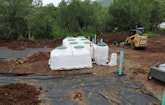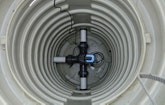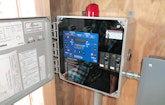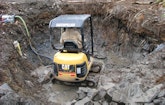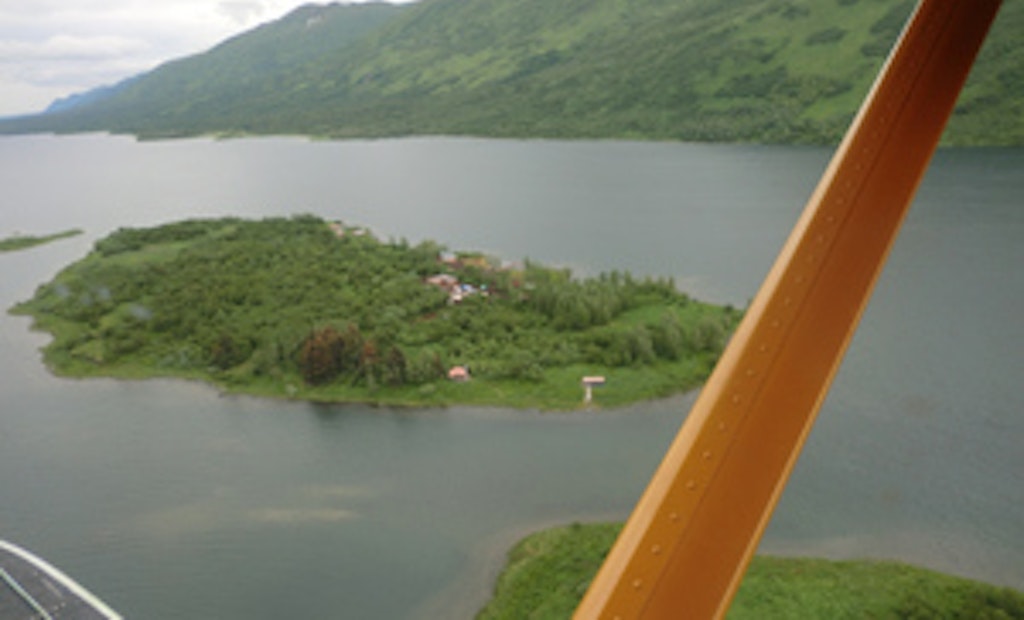Interested in Systems/ATUs?
Get Systems/ATUs articles, news and videos right in your inbox! Sign up now.
Systems/ATUs + Get AlertsKoniag, an Alaska Native corporation, is building a world-class bear viewing and research facility on Camp Island in Karluk Lake on Kodiak Island. The Kodiak Brown Bear Center houses 40 people and has two full-service kitchens and a laundry.
The area has one of the highest densities of Kodiak brown bears in the world and a diverse ecosystem. Its onsite treatment system had to meet strict discharge limits, function with little to no downtime, and require minimal maintenance.
Ed Ward, the center’s general manager, hired Jeff Garness, P.E., owner of Garness Engineering Group in Anchorage, to design the system. Senior engineering technician Jody Maus developed the materials list. Garness chose septic tanks, a pump station, a recirculation tank, and open-cell foam fixed-film filters discharging to chambers.
“Compiling the materials list was huge,” says Ward. “If Jody forgot anything, we could add $1,225 to the cost for the float plane from Kodiak.” Freight for the system cost 1.5 times as much as the installation.
Ward and his crew faced unbroken wilderness, a short work season, challenges of coordination with other subcontractors, and deer and bears that seemed to believe the workers were building a playground for them. Once installed, the system operated as designed even at minus 20 degrees F.
Site conditions
Soils are sandy loam and overburden (peat and fines) on a thin layer of clay over shale bedrock three to six feet below grade. The loading rate for highly treated effluent is 0.6 gallons per square foot per day. Winds blow in excess of 100 mph.
System components
Garness designed the system to handle 2,400 gpd. The major components are:
• Four TW 1,250-gallon fiberglass septic tanks with Polylok A-300 effluent filters in the second compartment. All tanks made by Infiltrator Systems.
• 500-gallon fiberglass pump tank with duplex 1/2 hp Quanics effluent pumps and SIM/TECH pressure filters.
• 1,500-gallon recirculation tank with duplex 1/2 hp Quanics effluent pumps and SIM/TECH pressure filters.
• Four 1,050-gallon AeroCell recirculating trickling filter modules with Quanics gravity recirculation device in a 24-inch basin.
• GUV-3 gravity UV disinfection unit (3 gpm or 4,320 gpd), Quanics.
• 100 Quick4 chambers from Infiltrator Systems.
• Control panels, Quanics.
System operation
Graywater from kitchens in two buildings tees into the sewer gravity line. Laterals and mains are 4-inch PVC pipe. Wastewater flows through the septic tanks and into the pump tank. Alternating pumps run for five minutes, sending 100 gallons every 15 minutes 500 feet through 1.5-inch HDPE pipe to the recirculation tank, where it mixes with treated effluent. The line drains back to the pump tank after each cycle.
Every 15 minutes, the pumps in the recirculation tank activate for three minutes, sending 100 gallons to the secondary treatment modules set in series. Helical spray nozzles in the units evenly distribute effluent over the media. The porous foam cubes have a large surface area for microbial attachment, allowing high loading rates.
A gravity collection system at the bottom of the last module sends 80 percent of the effluent to the recirculation tank and 20 percent through the disinfection unit to the drainfield. During low flows, a float valve changes the recirculation rate to 100 percent.
The recirculation device in the last module sends 25 gallons to a flow divider through 2-inch Schedule 40 PVC pipe. The two 15- by 45-foot zones in the drainfield each have five laterals three feet on center and 45 feet long. Effluent will average 10 mg/L TSS and BOD with 99 percent reduction in fecal coliforms and no pathogens.
Installation
Every element of the system and redundant parts were shipped from Crestwood, Ky., to Seattle, Wash., to Anchorage, then by landing craft to Uyak Bay, the staging area on Kodiak. A helicopter flew the materials over a mountain range to the installation site.
The island had no equipment. After a 301.8 Caterpillar mini excavator, one of the smallest made, and 247B Caterpillar track loader arrived at Uyak Bay, workers took them apart to fit the helicopter’s 3,000-pound lift capacity. Both machines required four airlifts. It took 26 lifts and two days to import the onsite components and equipment.
The island had no utilities. Ward built a power generation system with diesel generators, inverters, batteries, solar panels and wind turbines, and a 2,400 gpd water-processing facility.
“We needed heavy equipment to excavate the 22- by 80- by 12.5-foot-deep hole for the septic tanks and pump station, but airlifting it wasn’t economically feasible,” says Ward. “Instead, we flew in a small hydraulic hammer attachment and spent six weeks chipping through bedrock and moving 800 cubic yards with the mini excavator.”
During excavation, Ward struck a vein of fines that he stockpiled for bedding and backfill. “If we hadn’t found it, we would have had to import material with a skiff,” he says. With the water table five feet below grade, Ward ran two 2-inch Honda trash pumps continuously during the excavation and filtered the discharge to prevent silt from entering the lake. He built the filter from 8-inch PVC pipe and geotextile fabric, directing the discharge to a small swale enclosed by silt screens and straw bales. Ward later used the accumulated sediment for backfill.
Ward graded a slope to the excavation, then bedded the area with six inches of gravel. He set each tank on a 1.5-inch-thick plywood sheet and dragged it into place with the excavator. Eight people manhandled the 300-pound septic tanks into final position, then filled them half full with water and backfilled to the mold seam.
Meanwhile, Ward extended the forks on the loader to set the aerobic units. After Maus plumbed the system, the two-member crew placed two layers of 2-inch rigid foam insulation over the components to protect them from freezing. They bedded and covered the pipes with 12 inches of fines and added three feet of overburden for insulation.
To prepare the drainfield on a hill, workers cut trees, pulled stumps, removed 2- and 3-foot boulders, stockpiled the overburden, and graded the site. Ward then began the time-consuming process of hauling fines up the hill with the loader while the crew laid the laterals. The final stage was building two sheds for the control panels.
Throughout the installation, bears played bulldozer in the dirt and gnawed on the aerobic units. Teething cubs chewed on everything. When Ward tired of repairing the damage, he posted a guard overnight. “The deer were fascinated by the excavator arm,” says Ward. “We had about 16 of them watching every bucket that came out of the ground or gathered around the spoil piles looking for food.”
The possibility of food caused fights between the deer and bears as to who would enjoy it. Several times, Ward had to break up their quarrels.
Ward installed the system before winter. In December, a warm spell melted two feet of snow. Within 18 hours, the primary tanks were under a foot of water with ice below. “I heard the high water alarm go off at 8:30 that night,” says Ward. “Two days before, I had chased a huge boar from the pump tank, but hadn’t looked at it.”
In the flashlight beam, he saw that the bear had deformed the lid and water was pouring in. Ward and a helper quickly cut drainage ditches. Ward replaced all riser lids with screw-down covers that were more difficult for the bears to deform and tear off.
Maintenance
Ward erected an electric fence around the tanks. He services the system, checking the condition of the media, vents, air supply and lids. He also removes and cleans the spray nozzles and inspects the pumps, controls, and effluent filters.

